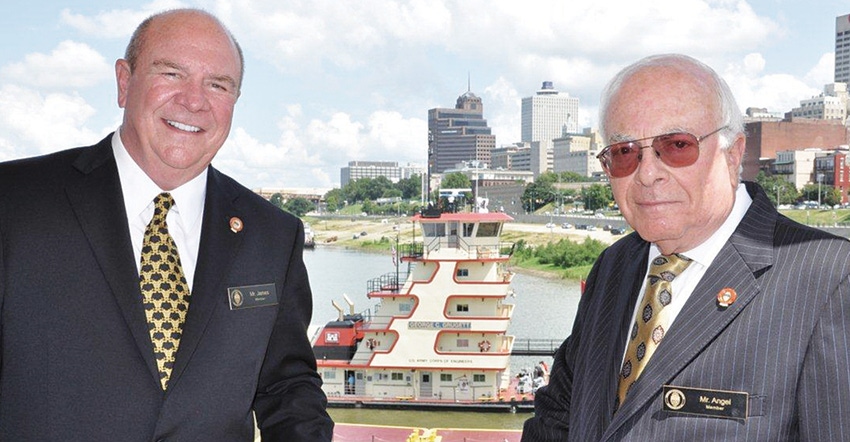
Preventing the Mississippi River from flooding valuable cropland during periods of heavy rainfall and/or snow melt, keeping its channel navigable even during droughts, and dredging harbors and ports so grain can be shipped are just some of the duties of the Mississippi River Commission.
Two Mid-South grower/ginners — R.D. James, A.C. Riley Cotton Company, New Madrid, Mo., and Sam Angel, Epstein Gin Company, Lake Village, Ark. — are long-time MRC members.
“The lower Mississippi Valley drains 41 percent of the United States, including 31 states and two Canadian provinces,” James explains. “That water has to be controlled during floods, and as best possible, navigation has to be kept open during droughts. The structures that we put into the river — the dikes and jetties — help keep the center of the channel at a depth so navigation can continue even during dry seasons.”
James says the Mississippi River Commission is the only governmental commission he knows that yearly holds public meetings to better understand local needs.
SEMI-ANNUAL INSPECTIONS
“We conduct semi-annual inspection trips and public hearings at various locations along the river, from Cairo to the Gulf. We hold preannounced public meetings to hear the concerns of levee boards, drainage districts, cities, towns, and anyone else with an interest in flood control or navigation. They tell us what’s right and what’s not right in their part of the world.”
The commission deliberates on what it hears, and an engineering staff reviews testimony and develops engineering recommendations that are presented to the commission, which then passes its recommendations on to the President and Congress.
The commission also oversees the implementation of the comprehensive Mississippi River and Tributaries project under the supervision of the chief of Engineers. The project is a system of flood control and navigation from Cairo to the Gulf that was authorized in 1928 following the devastating flood of 1927.
No project levee has ever failed, despite several major floods since the inception of the project. Subsequently, the frequency of flooding in protected areas has declined, resulting in a sharp drop in flood damages.
SYSTEM STILL NOT COMPLETE
“However, almost 90 years later, that system is still not complete,” James says. “We have levees on the southern end of the system, particularly in Louisiana, that have not yet been raised to the designed grade. We’ll continue working on that, but we can’t get enough funding for the capital expenditures we need to make.”
Another example of a Mississippi River and Tributaries project is the St. Francis system. “The Little River Drainage District in Missouri is a large drainage district that keeps their ditches clean, mowed, and in top shape,” James says.
“But its extension down in Arkansas is the responsibility of the Corps of Engineers. That part of the district hasn’t received maintenance or cleanout for many years, which causes problems in the Arkansas area — and even back into Missouri — because the system doesn’t drain properly. Again, we need more funding to clean out that stretch of the St. Francis basin to allow the water to drain into the Mississippi River.”
PORTS AND HARBORS
Another key responsibility of the commission is dredging the 17 small ports and harbors in the lower Mississippi Valley. “It’s our responsibility to try to keep those ports and harbors open,” James says. “Mostly what comes out of those ports and harbors is grain loaded on barges.”
“These ports and harbors have been funded individually in the past. For example, Hickman Harbor might’ve received its funding, while Greenville Harbor might not. We’ve been working to get them coordinated, so they’re funded as a group. Then through engineering analysis, and not just political and money analysis, we can decide which ones need dredging each year.
“We’re making pretty good progress toward that goal. Sometimes we’re a little light in funding and can’t do it to my satisfaction, as far as getting to all of them every year, but it’s better than it was. If growers couldn’t haul their grain to the river elevators, they would pay dearly to get on the highways or rails because the basis would be much higher.”
The 1879 law that established the Mississippi RIver Commission calls for its membership to consist of three U.S. Army Corps of Engineers officers, one member of the National Oceanic and Atmospheric Administration (formerly the Coast and Geodetic Survey), and three civilians, two of whom must be civil engineers. Each member of the commission is nominated and appointed by the U.S. President, and confirmed by the Senate.
The originating legislation granted the commission extensive jurisdiction on the Mississippi River, from its headwaters at Lake Itasca, Minn., to the Head of Passes near the Gulf of Mexico. The act also empowered it to make surveys and conduct investigations necessary to prepare plans to improve the river channel, protect riverbanks, improve navigation, prevent destructive floods, and promote commerce.
A 45-TO-1 RETURN
The Mississippi River and Tributaries project is arguably the most successful civil works project ever initiated by Congress. From 1928 through 2015, the nation invested nearly $14.8 billion in the project and received an estimated $639 billion return on that investment, including savings on transportation costs and flood damages, a 45-to-1 return for every dollar invested.
“That’s probably the highest return in the nation on a government project,” says James, who has served on the commission since Dec. 1, 1981. “The project greatly benefits Mid-South agriculture in many ways. I’m a farmer and ginner, in addition to being a civil engineer, and I and the commission remain dedicated to making sure Mid-South agriculture will continue benefiting from the project.”
About the Author(s)
You May Also Like




